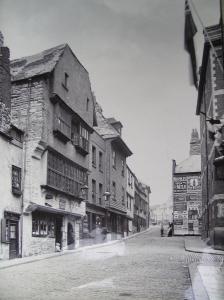Tags
 ONCE again Bygones readers have responded in their droves to an appeal for help in identifying the location of a Richard Keene picture.
ONCE again Bygones readers have responded in their droves to an appeal for help in identifying the location of a Richard Keene picture.
While several readers suggested Derby connections, including one who thought it may have been taken in Green Lane, three others have looked further afield to Devon.
Mark Higginson, of West Hallam, believes the photo was taken in St Andrew’s Street, Plymouth, looking north, probably in the 1880s.
He said: “I am sure others will also be able to identify it as the most prominent building in the photo still exists, looking somewhat different now, though not as different as the locality surrounding it.
“The buildings lining the left-hand side of the road are all very ancient (which could be why Keene chose to photograph them, probably thinking they might soon disappear).
“Close examination shows them to be almost certainly of 16th century or Tudor date, but re-fronted, modified and bodged to such an extent that their ancestry is difficult to fathom.
“The nearest building is the most significant as it displays jettying on three floors, which indicates the building is timber-framed. Jetties were where the upper floors were cantilevered outwards, so maximising the floor area of the building without increasing its footprint at ground level.
“They were fashionable because they enabled an owner to advertise both his wealth and status. Up top, the odd and ugly-looking roofline began life as a pair of matching gables, which at some point in the building’s history had the valley between them covered over to create a larger attic space.
“The heavy-handed render on the front obscures the original timber framing and was perhaps applied to make it look less dated or to keep out the weather. So, what was by the late 19th century a rather ramshackle-looking shop, had actually originated as a fine Elizabethan town house of some quality.
“The building – now known as the Merchant’s House – is a museum run by Plymouth City Council which, in the 1970s, undertook work to restore it to something like its original appearance. It is said to be the largest and finest surviving example of a 16th/early 17th-century house in Plymouth.”
Rodney Tomkins, of Heage, agrees with Mr Higginson’s location. He added: “The upper storey now displays twin gables while Tudor beams have been uncovered between the rows of windows.
“The house to the left has now gone and the road has been blocked beyond the building by a towering multi-storey concrete car park.”
Alison Robbins, of Borrowash, also spotted a Devonshire connection. She said: “The prominent building on the left is characteristic of ancient Devonshire towns, being remarkably similar to the museum in Totnes.
“This is definitely not Totnes but I suspect it is a small town of similar age. The very thick stone wall, which separates this building from the next, was required by law after the Great Fire of London to prevent fires from spreading as fast as they did in the closely-packed wooden houses of 1666.
“This building, then, is post-1666 and dates from the very late 17th or early 18th century. Grand houses like this were often built by merchants who had grown rich on the wool trade.
“The building two along appears to have a covering of cemented slate-hangings, another Devonshire characteristic.”
